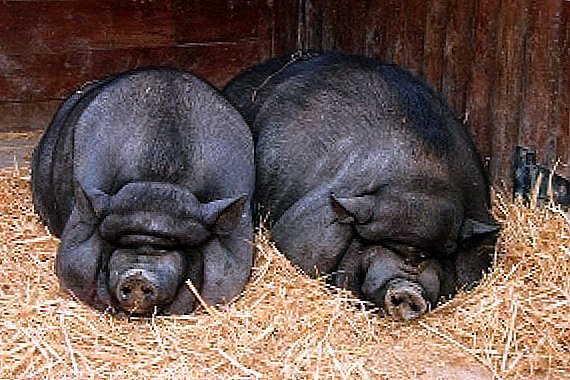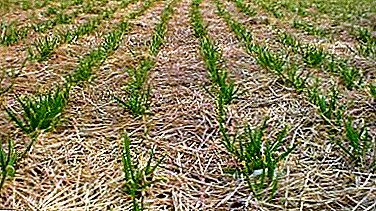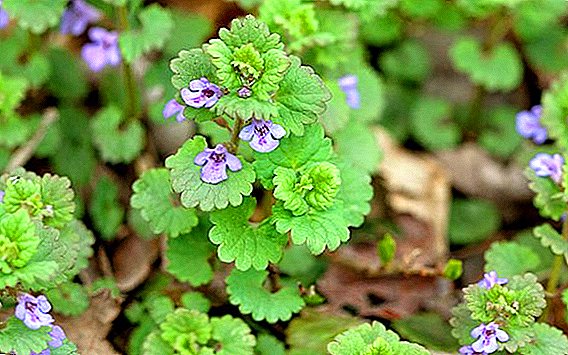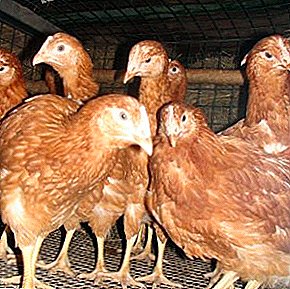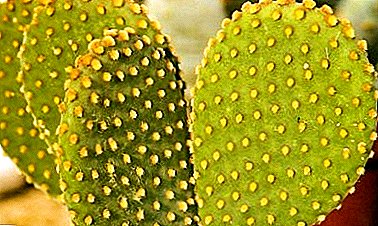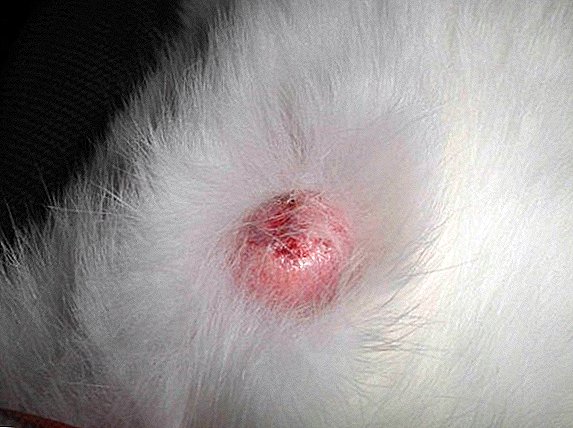 Rabbits that are fastidious in keeping and feeding conditions require certain knowledge from the breeders in the field of veterinary medicine. This article will help in solving the problem of mastitis in female rabbits.
Rabbits that are fastidious in keeping and feeding conditions require certain knowledge from the breeders in the field of veterinary medicine. This article will help in solving the problem of mastitis in female rabbits.
What kind of disease and how it is dangerous for the rabbit
Mastitis is an extremely dangerous disease, not only for female rabbits, but also for any kind of mammal. The disease is a very painful inflammatory condition of the breast. Accompanied by high fever, swelling, redness and cessation of excretion of milk from the affected nipple. 
Kids who have to starve die in a matter of days. The position of the mother remains mortally dangerous. Timely detection of a problem, quick response and access to a doctor can save a sick female.
Important! Predisposition to mastitis can be inherited. This fact must be taken into account by breeders.
Causes of the disease
- Among the main causes of mastitis (infectious) are infection with streptococcus, staphylococcus, tubercle bacillus and other pathogens. The infection penetrates through various skin lesions (cuts, bites of newborns, scratches, bruises, injuries of the mammary gland, etc.). A body weakened by childbirth is easily susceptible to infection.
- Often, the appearance of mastitis (non-infectious) is associated with blockage of ducts, and as a result, overflow and stagnation of produced milk in the gland of a nursing individual. This problem (lactostasis) occurs in the postpartum period and with the sudden removal of the baby rabbits from the mother. Milk is produced more than the existing rabbit needs.
- The following reasons for the development of mastitis can be the presence of endocrine or other abnormalities in the body of the female, painful hypothermia or burn condition of the skin of nursing rabbits. Often, these phenomena are accompanied by purulent processes. Which greatly aggravates the situation.
Important! Limit the amount of green fodder containing phytoestrogens (for example, kale, soybeans, lentils, red clover ...). Excessive amounts of phytoestrogens can cause a blockage in the production by the female of her own sex hormones and cause a malfunction of the reproductive system. These phenomena predict the appearance of mastitis in many cases.
How to recognize
To determine the presence of mastitis help both direct external signs, and indirect (additional). 
Direct external signs
- Unhealthy mammary gland acquires a reddish hue, reacts sharply to any contact with it, it becomes hot, dense to the touch. Even light pressure on a sore reddened nipple causes severe pain.
- The squeezed out milk gets watery structure with white flakes (reminds old kefir).
- Pus clogs the ducts and milk is not excreted at all.
- The nipples are affected by droplets of pus or thick liquid with bloody patches.
- Body temperature reaches 39 ° C, heavy breathing quickens.
In this situation, urgent medical intervention is necessary.
Did you know? The number of rabbits with full freedom of breeding in ninety years would be equal to the number of square meters on Earth.
Indirect (optional)
The initial symptoms of mastitis in a nursing female are her extreme apathy, indifference even to her own offspring (sometimes, on the contrary, aggression), lack of appetite, weakness, drowsiness, or refusal to sleep for a long time. A healthy female eats well and plentifully, additionally deals with nest equipment and does not move away from her beloved children, often feeds them, smells them. Increasing pain, discomfort, stress do not allow a sick rabbit to enjoy motherhood.  Possible accompanying signs of mastitis can also be increased thirst, tattered fur, diarrhea. In such cases, a thorough inspection of the rabbit is required. Particularly dangerous illness will be for primiparas who have not yet met with lactation. Increased risk of disease in females feeding small offspring for various reasons.
Possible accompanying signs of mastitis can also be increased thirst, tattered fur, diarrhea. In such cases, a thorough inspection of the rabbit is required. Particularly dangerous illness will be for primiparas who have not yet met with lactation. Increased risk of disease in females feeding small offspring for various reasons.
How mastitis progresses
The beginning inflammatory process grows every day, striking new sites. The skin around the nipple darkens, becoming brown-blue, soon black, and then die. The temperature of the inflamed areas and the entire body of the female quickly increases, leading to increased thirst and frequent water consumption. The female stops feeding the cubs.
Rabbits are prone to many diseases - learn about them.
If at the initial stage of the disease (the first day) a milk-like liquid is released, then soon it becomes a curd-kefir mass (the result of the folding process). In particularly advanced cases, a purulent abscess occurs and, instead of milk, iron accumulates pus with bloody patches. Pus tubercles near the nipple grow (up to 2 cm or more) and erupt by greenish-bloody pus. The growing inflammatory process can even spread to the back. The rate of the disease is different and depends on many factors.  Share:
Share:
- acute mastitis (up to two weeks). In the case of a clinical form (unusually rapidly progressing), death occurs in the first three days;
- subacute (up to six weeks);
- chronic or subclinical (over six weeks). Particularly dangerous because they usually have a latent form of manifestation for a long time.
Important! The female, who once had mastitis, automatically falls into the risk zone to fall ill again.
What to do, how to treat mastitis in a rabbit
Early detection of mastitis predicts almost 100 percent success rate of recovery, but a running inflammatory process does not lend itself to successful treatment even by an experienced veterinarian. Therefore, it is important to conduct an examination of the mammary glands (nipples and adjacent areas) in the first hours after birth. 
In the initial stage
In the initial stage, the changes are minor. There is a slight reddening and unnatural (asymmetry can be traced around the nipple area, that is, not all of the lobes of one gland are the same) or uneven (one or several glands more than the rest) swelling of the mammary rabbits. A palpation reveals nodules and painful indurations.
The incubation period reaches five days, so that examinations of pregnant and lactating females should be regular. Having found these defects in the rabbit, we transplant the rabbits to another nurse or arrange artificial feeding for them. The little rabbit is transferred to quarantine, and we thoroughly disinfect the cage and utility equipment.
Read more about how to determine the rabbit suckling, why the rabbit scatters rabbits immediately after the hunt and behaves aggressively.
Limit fluid intake and succulent root crops
We limit the amount of water consumed and juicy feed. Otherwise, the increasing amount of milk will make the female position worse and worsen the illness. 
To do obliteration (to hand over skap-lending liquid)
To alleviate the condition of the rabbit infected with the disease, we perform a nipple massage, paying special attention to the compacted areas. Strain accumulated fluid from the affected gland (do obliteration). The procedure is carried out at least three times a day (sometimes more, depending on the general condition of the patient specimen). After a while, rabbits can be connected to the treatment (if there is no deterioration), which instinctively give the mother a massage and suck out the milk from problematic hard-to-reach areas.
Did you know? Rabbits are endowed with unique eyes, the structure of which allows him to see what is happening behind, without making a turn of the head.
We continue the treatment until the milk starts to easily and trickle out of the affected gland. The mummy will cease to avoid his cubs, and the babies are fed up and calm will fall asleep near her.
Inject antibiotics
When the disease enters the more acute form, we perform subcutaneous and intramuscular injections of the antibiotic. Penicillin is the most famous of them. Injections are repeated after six hours on the first day and are held in different parts of the body. Further, the number of injections is reduced to three, and then to two per day. Disposable rate reaches 25 thousand units. per kilogram of live weight. Undesirable penicillin (many side effects) can be replaced by bicillin (do not change the dosage) or oxytetracycline (0.1 ml per kg of weight).  Part of the medicine of the first injection is used for obkalyvaniya affected parts of the gland. If possible, antibiotics can be injected through the teat canal (cysteral). Only three days after the last injection are allowed to admit babies to the mother's milk.
Part of the medicine of the first injection is used for obkalyvaniya affected parts of the gland. If possible, antibiotics can be injected through the teat canal (cysteral). Only three days after the last injection are allowed to admit babies to the mother's milk.
Make compresses
By connecting to the above procedures warming compresses, you can provide a faster and more successful recovery. For these purposes, alcohol, water and paraffin types of wraps are used. Quite good results show rubbing actions of camphor, ichthyol ointment, synthomycin liniment. Of the newest developments, the drug Pihtoin is proposed, which is based on pine resins and beeswax. Do not violate the proposed dosage.
Learn all about breeding rabbits at home.
Include in the diet complex vitamin-min-ny drug
To raise the overall tone and strengthen the body in the fight against the disease, it is recommended to take complex vitamin preparations. You can add them to the liquid, some of them rabbits eat independently. Usually take courses for 14-21 days or as prescribed. One of the best are the drugs Chiktonik, Biofactory Aminosol. 
Purulent mastitis
Severe (purulent) form of mastitis requires the implementation of all actions considered. However, in addition to getting rid of the glands from the fluid, warming, administering drugs, urgent removal of ulcers is required. The place of removal is treated with antiseptic. Using a disinfected instrument, open the abscess and remove the contents, wash the cleaned wound with a solution of potassium permanganate, furacillin or rivanol, streptocide and fix the bandage.
Important! Rabbits, later taken away from the mother with purulent mastitis and transplanted to another nursing female, will inevitably infect her.
During the entire period of the disease, enhanced compliance with hygiene measures and careful treatment of the cell (room) with disinfectants are required. It is necessary to take into account the fact that the recovery of the female does not guarantee the normal production of milk by the diseased glands (most likely, they will lose this opportunity).
In addition, often mastitis is accompanied by the appearance of comorbidities, such as general infection with staphylococcus (pustular rash all over the body), purulent abscesses on the feet (the female does not sit still, constantly step over from paw to paw).  In this case, the opened and cleaned wounds are disinfected with a 3% solution of carboxylic acid or a 5% alcohol solution of pyoctanine. Purulent mastitis requires scrupulous and responsible treatment, so it’s best to contact a veterinarian or a knowledgeable experienced rabbit grower. The meat of diseased animals is considered contagious, it is better to dispose of it.
In this case, the opened and cleaned wounds are disinfected with a 3% solution of carboxylic acid or a 5% alcohol solution of pyoctanine. Purulent mastitis requires scrupulous and responsible treatment, so it’s best to contact a veterinarian or a knowledgeable experienced rabbit grower. The meat of diseased animals is considered contagious, it is better to dispose of it.
Prevention
In prophylactic purposes to prevent the occurrence of the disease it is necessary:
- Before caulking, complete firing of all cells, general cleaning and disinfection of equipment and inventory. Worn old cells must be replaced with new ones;
- ensure the purity and availability of an additional layer of dry bedding of the room where the feeding females and her offspring are kept
- eliminate the possibility of drafts and dampness, overcooling of individuals;
- to feed the feeding individual with exceptionally warm water;
- give full fodder, hay and greens;
- protect the rabbit's peace, protecting it from sudden movements and frightening sounds;
- remove all kinds of piercing and hurting objects near the location of the female;
- timely inspect the rabbit after childbirth and the first days of life of babies;
- provide timely treatment of postpartum trauma and complications.
Did you know? A predator can scare a rabbit to death (literally).The most resistant to disease are rabbits, purchased from proven breeders, on large farms, in nurseries. Note that there is a special vaccine - the sta-phlococyan toxoid. Its use is designed for two stages and the first injection of subcutaneous injection (0.5 ml) is carried out on the 10th-12th day of pregnancy of the female, the second - on the 15-17th day.
 Vaccination is carried out in farms with increased incidence of females with mastitis. The conclusion suggests itself: do not forget to do inspections of pregnant and lactating rabbits. It is better to detect mastitis at an early stage than to eradicate the effects of deep infection in advanced cases.
Vaccination is carried out in farms with increased incidence of females with mastitis. The conclusion suggests itself: do not forget to do inspections of pregnant and lactating rabbits. It is better to detect mastitis at an early stage than to eradicate the effects of deep infection in advanced cases.


